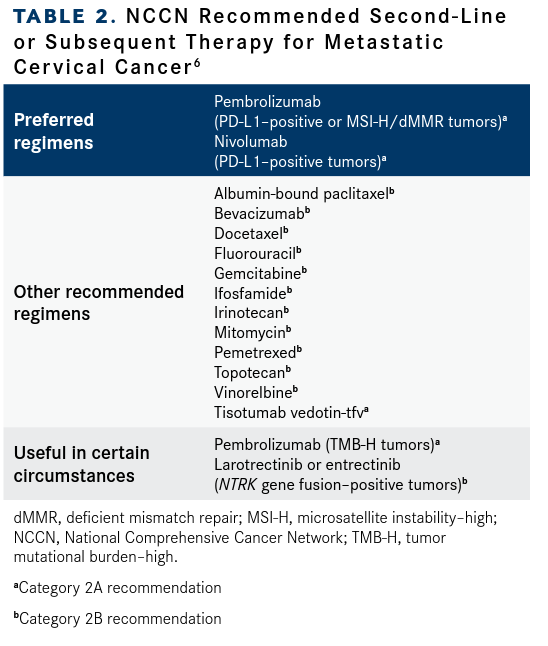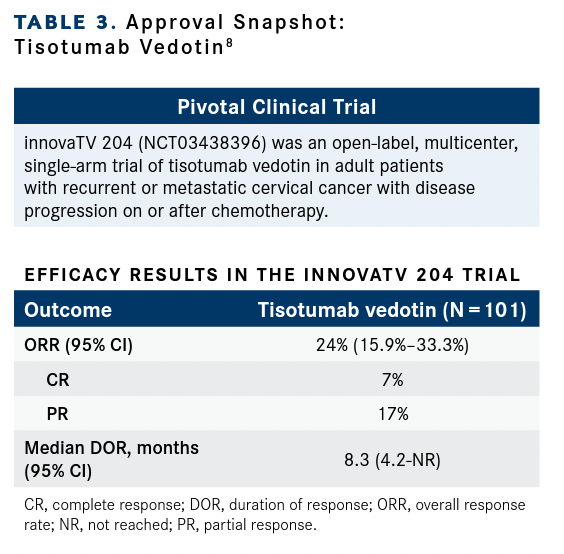Publication
Article
Oncology Live®
Cervical Cancer Treatment Paradigm Is Bolstered With Newly Approved Therapies
Author(s):
Treatment of patients with metastatic cervical cancer remains challenging—the 5-year overall survival rate is just 17%.
Bradley Monk, MD, FACOG, FACS

Treatment of patients with metastatic cervical cancer remains challenging—the 5-year overall survival (OS) rate is just 17%.1 Whereas many other solid tumors have seen a plethora of FDA approvals of clinically meaningful treatments, there has been a paucity of new approvals for metastatic cervical cancer. However, the tide began to turn in 2021 with several new treatments receiving FDA approval and showing a meaningful incremental benefit over previously available agents.
During a recent OncLive Peer Exchange®, a panel of experts in gynecologic cancer shared their insights on the treatment landscape for metastatic cervical cancer in the first- and second-line settings, including data for the newly approved agents and considerations for using them in clinical practice. They also discussed several promising checkpoint inhibitors on the horizon. “It’s exciting to see this flurry of activity in cervical cancer. We have tripled the survival [rate], which is heartwarming and incredible for our patients. This field is going to continue to evolve,” Bhavana Pothuri, MD, said.
Bhavana Pothuri, MD

First-Line Metastatic Cervical Cancer Treatment
Managing metastatic cervical cancer in the firstline setting includes treating women with de novo stage IVB or recurrent cancer after chemotherapy or radiation, Bradley Monk, MD, FACOG, FACS, said. “We don’t count chemotherapy or radiation as a line of therapy,” he said.
In patients with metastatic cervical cancer, the standard chemotherapy backbone remains paclitaxel (Taxol) and platinum, either cisplatin or carboplatin. “We were originally using a cisplatin backbone and the JGOG [Japanese Gynecologic Oncology Group] trial demonstrated noninferiority between carboplatin and cisplatin, except for those [patients] who had not received cisplatin previously as a part of their RT [radiation therapy] planning,” Warner K. Huh, MD, FACOG, FACS, said.
Warner K. Huh, MD, FACOG, FACS

The panelists proceeded to discuss 2 practice-changing, phase 3 clinical trials that have assessed additions to the standardof-care chemotherapy backbone of paclitaxel plus platinum in the firstline setting: the Gynecologic Oncology Group GOG 240 trial (NCT00803062), which investigated the addition of bevacizumab (Avastin), and KEYNOTE-826 (NCT03635567), which investigated the addition of pembrolizumab (Keytruda).
GOG 240
In 2014, the FDA approved bevacizumab in combination with standard-of-care chemotherapy based on data from the GOG 240 trial, making it the first drug approved for patients with late-stage cervical cancer since the 2006 approval of topotecan with cisplatin.2 “[GOG 240] showed that by incorporating antiangiogenesis therapy into platinum and nonplatinum chemotherapy doublets we could significantly improve survival in women with recurrent metastatic cervical cancer in the first line,” Krishnansu S. Tewari, MD, said.
Krishnansu S. Tewari, MD

The study randomly assigned 452 women with persistent, recurrent, or late-stage cervical cancer to receive paclitaxel and cisplatin with or without bevacizumab, or paclitaxel and topotecan with or without bevacizumab. In those receiving the triplet, OS reached 16.8 months, whereas those receiving chemotherapy alone had an OS of 12.9 months, showing a 3.9-month OS benef it with the addition of bevacizumab. Extended follow-up showed the benef it of incorporating bevacizumab to be sustained, with an OS of 16.8 months with the triplet and 13.3 months with the chemotherapy doublets, demonstrating a 3.5-month OS benefit with the addition of bevacizumab (HR, 0.77 95% CI, 0.62-0.95; P = .007).3
Although there is a small OS benefit with the addition of bevacizumab to standard-of-care chemotherapy, the panelists indicated that not all patients are candidates for this treatment. “There are contraindications, [including] fistula, GI [gastrointestinal] perforation, nonhealing wounds, proteinuria, uncontrolled hypertension, inflammatory bowel disease, [and] a history of diverticulitis,” Monk said.
Despite such contraindications, the panelists indicated that many of their patients are treated with the triplet. “Approximately 85% of my patients will get the triplet,” Pothuri said, noting she is thoughtful about counseling her patients on the benefits and drawbacks of treatment with bevacizumab.
KEYNOTE-826
On October 13, 2021, just a few weeks after the OncLive Peer Exchange®, pembrolizumab received FDA approval in combination with chemotherapy with or without bevacizumab for patients with persistent, recurrent, or metastatic cervical cancer whose tumors express PD-L1 with a combined positive score (CPS) of at least 1, as determined by an FDA-approved test.4 This marked the first new first-line therapy approval for women with persistent, recurrent, or metastatic cervical cancer since bevacizumab’s approval in 2014. FDA approval of pembrolizumab was based on data from KEYNOTE-826, which showed improvements in the dual primary end point of progression-free survival (PFS) and OS with the addition of pembrolizumab to standardof-care chemotherapy.
Investigators of KEYNOTE-826 randomly assigned 617 women with persistent, recurrent, or metastatic cervical cancer in a 1:1 ratio to receive pembrolizumab 200 mg (n = 308) or placebo (n = 309) every 3 weeks for up to 35 cycles plus standard-of-care chemotherapy, with bevacizumab administered per investigator discretion.5 Of these patients, 548 had a PD-L1 CPS of at least 1 (273 in the pembrolizumab arm and 275 in the placebo arm) and 317 patients had a CPS of at least 10 (158 in the pembrolizumab arm and 159 in the placebo arm).
In the first protocol-specified interim analysis, among the 548 women with a PD-L1 CPS of at least 1, the median PFS was 10.4 months in the pembrolizumab arm and 8.2 months in the placebo arm. “That was a hazard ratio of 0.62, which is incredible. We have these results within the first 3 months, and you see those curves diverge,” Premal H. Thaker, MD, MS, said. A median PFS of 10.4 months was also observed when considering the 317 patients with a PD-L1 CPS of at least 10 (HR, 0.58; 95% CI, 0.44-0.77; P < .001) as well as the entire intention-to-treat population (N = 617; HR, 0.65; 95% CI, 0.53-0.79; P < .001).
Premal H. Thaker, MD, MS

“The OS hasn’t been accomplished yet,” Thaker said. Nevertheless, estimates of patients alive at 24 months significantly favor pembrolizumab versus placebo across all patient subgroups examined (TABLE 15).
TABLE 1. 24-Month Estimate of Patients Alive in the KEYNOTE-826 Trial by Subgroup

Thaker said that no unexpected adverse effects (AEs) were observed in the study. The most common grade 3 to 5 AEs included anemia, affecting 30.3% of patients in the pembrolizumab arm versus 26.9% in the placebo arm, and neutropenia, affecting 12.4% of patients in the pembrolizumab arm versus 9.7% in the placebo arm.5
A little more than 60% of patients in both the pembrolizumab and placebo arms received bevacizumab in addition to standard-of-care chemotherapy. “What I can’t tease out from the data is if you need bevacizumab for the pembrolizumab to work,” Tewari said, who was a study investigator and coauthor of the New England Journal of Medicine article outlining the interim results.5 Although the data are challenging to interpret, the panelists agreed that clinicians should continue to use bevacizumab when they deem it appropriate for their patients. “Pembrolizumab shouldn’t confuse that decision,” Monk said.
Second-Line Metastatic Cervical Cancer Treatment
Despite the recent advancement in treating patients with metastatic cervical cancer in the first-line setting, most patients progress and require second-line treatment. Although there are many second-line options available (TABLE 26), response and OS rates associated with these agents have been “fairly minimal,” Huh said. The panelists explained that response rates have ranged from 0% to 10% with physician’s choice of chemotherapy to 14.3% with pembrolizumab, demonstrating a great unmet need in this area.
Since response with available treatments is so low, Huh said he tries to put his patients on clinical trials whenever possible. Tewari agreed with this approach. “The space has blown up with trials, so fortunately most of our patients in need of second-line therapy in the last few years were able to secure a place on a study,” he said.
TABLE 2. NCCN Recommended Second-Line or Subsequent Therapy for Metastatic Cervical Cancer

The panelists noted that numerous promising agents are currently in clinical trials, with one such agent, tisotumab vedotin (Tivdak), recently approved by the FDA.7 The panelists said that the approval of tisotumab vedotin is particularly exciting because it has shown unprecedented response rates, reaching almost 25%.
Tisotumab Vedotin
On September 20, 2021, tisotumab vedotin was granted FDA accelerated approval for women with recurrent or metastatic cervical cancer with disease progression on or after chemotherapy.7 “It is the first antibody-drug conjugate [ADC] to get approved in a gynecologic malignancy,” Monk said. He explained that this agent “has a target, an antibody, a linker, and a cytotoxin” and that its promising efficacy may result from its multiple mechanisms of action, including monomethyl auristatin E–directed cytotoxicity and bystander and immunogenic effects.
Tisotumab vedotin received an accelerated approval from the FDA based on data from the phase 2, open-label, multicenter, singlearm innovaTV 204/GOG-3023/ENGOT-cx6 trial (NCT03438396).8 In the study, 101 women with recurrent or metastatic previously treated cervical cancer (ie, squamous cell, adenosquamous, or adenocarcinoma treated with no more than 2 previous systemic regimens for recurrent or metastatic disease) received at least 1 dose of tisotumab vedotin. After a median follow-up of 10 months, the confirmed objective response rate (ORR) was 24% (95% CI, 16%-33%), with 7 patients (7%) achieving complete responses and 17 patients (17%) achieving partial responses (TABLE 38).
TABLE 3. Approval Snapshot: Tisotumab Vedotin

“It’s game-changing….I have several patients who are excited to go on this drug,” Huh said. Other panelists reported similar sentiments among their patients because of the paucity of meaningful treatments, particularly for those who are PD-L1 negative and do not qualify for immune checkpoint inhibitors. Monk recounted the emotional response of one of his patients when he informed her of her biopsy results, tisotumab vedotin’s approval, and that it was a viable option for her. “This is an opportunity,” he said. Tewari agreed and said he is thrilled this agent has been approved because he has already seen some “phenomenal objective responses” in some of the study patients he treated.
Tisotumab vedotin was found to have a manageable toxicity profile. The most common AEs included alopecia (38%), epistaxis (30%), nausea (27%), conjunctivitis (26%), fatigue (26%), and dry eye (23%).8 Treatment-related AEs grade 3 or higher were reported in 28% of patients and included neutropenia (3%), fatigue (2%), ulcerative keratitis (2%), and peripheral neuropathies (2%). Serious treatment-related AEs occurred in 13% of patients, with peripheral sensorimotor neuropathy (2%) and pyrexia (2%) being the most common. There were 4 deaths, 3 of which were deemed unrelated to treatment and 1 attributed to septic shock from treatment.
Tisotumab vedotin has been found to cause changes to the corneal epithelium and conjunctiva, and its prescribing information has a boxed warning regarding its ocular toxicity.9 “It’s the linker that’s causing the ocular toxicity. It’s not the payload or the antibody,” Tewari said, noting that the mitigation strategies required by the FDA are highly effective in reducing the risk of ocular AEs, particularly severe AEs that can result in permanent vision loss. An ophthalmic exam is required at baseline, before each infusion, and as clinically indicated. Additionally, 3 types of eye drops are required throughout tisotumab vedotin treatment: vasoconstriction eye drops immediately before the infusion, topical corticosteroid eye drops for 72 hours after the infusion, and topical lubricating drops for the duration of treatment and up to 30 days after the f inal infusion.
Monk said when ocular AEs occur, they tend to happen early in treatment and are completely reversible. “You have to emphasize that,” he said, noting that eye concerns can be unsettling for patients. “For conjunctivitis, it’s primarily red eye. I’ve seen patients [who have] someone ask, ‘What’s wrong with your eye? Is that pink eye? Is that contagious?’ It’s disturbing, but it’s not serious,” he explained.
The panelists noted that dealing with intensive ocular care requirements can pose challenges for oncologists and patients, especially if patients need to see an ophthalmologist before every cycle, but they explained that such situations are not new for oncologists. “When I first started using this drug, I was scared and apprehensive, but now that I’ve seen the mitigation strategy I understand it, similarly to how we were scared with BEV [bevacizumab]. I remember learning about antihypertensives, and asking how many can we give? What should we give? But we’ve gotten better, and we will continue to improve,” Thaker said.
Checkpoint Inhibitors on the Horizon
The panelists noted that several new immune checkpoint inhibitors are being investigated for patients with metastatic cervical cancer, including balstilimab and cemiplimab (Libtayo). Balstilimab was under consideration as a monotherapy for this indication, but its biologic license application (BLA) was voluntarily withdrawn in October 2021 following FDA approval of pembrolizumab, which came 4 months earlier than the FDA goal date.10 Despite this setback, development of this agent is moving forward but as part of a combination therapy for metastatic cervical cancer and other tumor types.
One partner for the anti–PD-L1 antibody balstilimab that has shown promise is zalifrelimab, a CTLA-4 antibody. In a phase 2 trial (NCT03495882), after a median follow-up of 21 months, the confirmed ORR with the combination was 25.6% (95% CI, 18.8%-33.9%), which included 10 complete responses and 22 partial responses.11 In patients with PD-L1–positive tumors, the ORR reached 32.8%, whereas it was 9.1% in PD-L1negative tumors. Although responses were observed across histologic subtypes, the ORR was highest for patients with squamous tumors, reaching 32.6% (vs 8.8% of cervical adenocarcinomas). The overall disease control rate was 52% (95% CI, 43.3%-60.6%). Hypothyroidism (14.2%) and hyperthyroidism (7.1%) were the most common immune-mediated AEs.
“The response rate with the combination appears to be superior to single-agent [balstilimab],” Pothuri said. She surmised that “the addition of the CTLA-4 may help overcome the lack of efficacy with a single-agent checkpoint inhibitor” and suggested this combination may receive wide adoption if approved.
Similar to balstilimab, cemiplimab is a PD-L1 inhibitor. It was accepted for priority review in September 2021 as a treatment for patients with recurrent or metastatic cervical cancer whose disease progressed on or after chemotherapy.12 The supplemental BLA was submitted to the FDA based on data from the phase 3, open-label, multicenter EMPOWER-Cervical 1 trial (NCT03257267), which showed significant benefit with cemiplimab vs chemotherapy in global health status/quality of life, physical functioning, and key symptom scales. Importantly, cemiplimab also was associated with a survival benefit.14
“We showed a significant improvement in overall survival in the squamous cell population, which was the first part of our statistical hierarchy, 11 vs 8 months. We also showed a significant improvement in survival in the intention-totreat population [12.0 vs 8.5 months]. Although it wasn’t planned or part of the statistical hierarchy, the results with adenocarcinoma were thought-provoking [13.3 vs 7.0 months]. It was a tolerable monotherapy. We didn’t have to combine it with bevacizumab or chemotherapy. Going forward, this is an important option for patients,” Tewari said. The target action date for the FDA’s decision is January 30, 2022.12 A key feature of the trial is that patients were enrolled regardless of PD-L1 expression status, which may help extend checkpoint inhibitors to all-comers if ultimately approved.
In their concluding thoughts, the panelists expressed significant excitement for the future, noting that treatment development for patients with metastatic cervical cancer is only the tip of the iceberg but is progressing at a rapid pace. “In 2 years, I think the algorithm for how we treat patients with recurrent cervical cancer will be completely different. It’s the dawn of a new era. It’s incredibly exciting,” Huh said.
References
- Survival rates for cervical cancer. American Cancer Society. Accessed January 1, 2022. https://www.cancer.org/cancer/cervical-cancer/detection-diagnosis-staging/survival.html
- FDA approves Avastin to treat patients with aggressive and late-stage cervical cancer. News release. FDA. August 14, 2014. Accessed January 1, 2022. https://bit.ly/3pO7pph
- Tewari KS, Sill MW, Penson RT, et al. Bevacizumab for advanced cervical cancer: final overall survival and adverse event analysis of a randomised, controlled, open-label, phase 3 trial (Gynecologic Oncology Group 240). Lancet. 2017;390(10103):1654-1663. doi:10.1016/ S0140-6736(17)31607-0
- FDA approves Merck’s Keytruda (pembrolizumab) plus chemotherapy, with or without bevacizumab, as treatment for patients with persistent, recurrent or metastatic cervical cancer whose tumors FDA approves Merck’s Keytruda (pembrolizumab) plus chemotherapy, with or without bevacizumab, as treatment for patients with persistent, recurrent or metastatic cervical cancer whose tumors
- FDA approves Merck’s Keytruda (pembrolizumab) plus chemotherapy, with or without bevacizumab, as treatment for patients with persistent, recurrent or metastatic cervical cancer whose tumors
- NCCN Clinical Practice Guidelines in Oncology. Cervical cancer, version 1.2022. Accessed January 1, 2022. https://www.nccn.org/ professionals/physician_gls/pdf/cervical.pdf
- FDA grants accelerated approval to tisotumab vedotin-tftv for recurrent or metastatic cervical cancer. News release. FDA. Updated September 21, 2021. Accessed January 1, 2022. https://bit.ly/3JCyEeq
- Coleman RL, Lorusso D, Gennigens C, et al; innovaTV 204/GOG3023/ENGOT-cx6 Collaborators. Efficacy and safety of tisotumab vedotin in previously treated recurrent or metastatic cervical cancer (innovaTV 204/GOG-3023/ENGOT-cx6): a multicentre, open-label, single-arm, phase 2 study. Lancet Oncol. 2021;22(5):609-619. doi:10.1016/S1470-2045(21)00056-5
- Tivdak (tisotumab vedotin-tftv). Prescribing information. Seagen; 2021. Accessed January 1, 2022. https://seagendocs.com/Tivdak_Full_Ltr_Master.pdf
- Agenus provides update on balstilimab development. News release. Agenus. October 22, 2021. Accessed January 1, 2022. https://bit.ly/3zCyuzf
- O’Malley DM, Neffa M, Monk BJ, et al. Dual PD-1 and CTLA-4 checkpoint blockade using balstilimab and zalifrelimab combination as second-line treatment for advanced cervical cancer: an open-label phase II study. J Clin Oncol. Published online December 21, 2021. doi:10.1200/JCO.21.02067
- FDA accepts Libtayo (cemiplimab-rwlc) for priority review for advanced cervical cancer. News release. Regeneron. September 28, 2021. Accessed January 1, 2022. https://bit.ly/3pSRVjL
- Oaknin A, Monk BJ, Vergote I, et al. Impact of cemiplimab on quality of life (QoL), functioning and symptoms in patients (pts) with recurrent/metastatic (R/M) cervical carcinoma: results from EMPOWER-Cervical 1/GOG-3016/ENGOT-cx9. Ann Oncol. 2021;32(suppl 5):S755-S756. Abstract 783P. doi:10.1016/annonc/annonc703
- Tewari KS, Monk BJ, Vergote I, et al. EMPOWER-Cervical 1/GOG3016/ ENGOT-cx9: Interim analysis of phase III trial of cemiplimab vs. investigator’s choice (IC) chemotherapy (chemo) in recurrent/ metastatic (R/M) cervical carcinoma. Ann Oncol. 2021;32(7):940941. doi:10.1016/j.annonc.2021.04.009


























%20(2)%201-Recovered-Recovered-Recovered-Recovered-Recovered-Recovered-Recovered-Recovered-Recovered-Recovered-Recovered-Recovered-Recovered-Recovered-Recovered-Recovered-Recovered.jpg?fit=crop&auto=format)
%20(2)%201-Recovered-Recovered-Recovered-Recovered-Recovered-Recovered-Recovered-Recovered-Recovered-Recovered-Recovered-Recovered-Recovered-Recovered-Recovered-Recovered-Recovered.jpg?fit=crop&auto=format)
